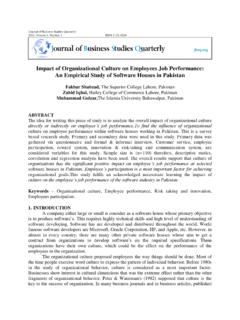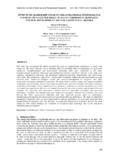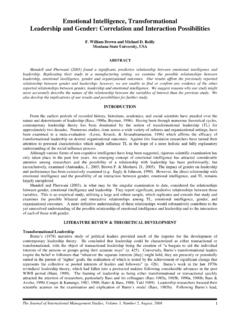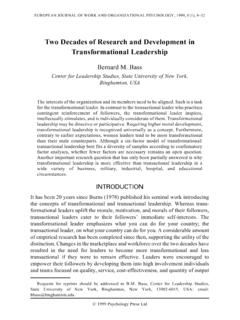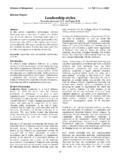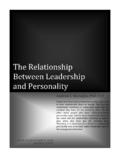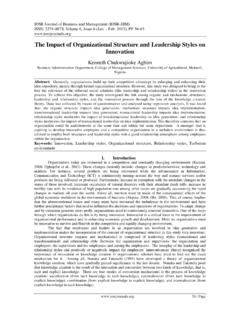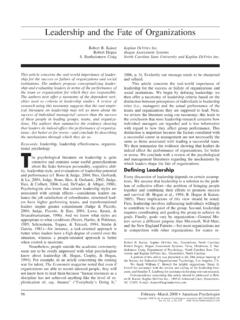Transcription of Emotional Intelligence and Effective Leadership - …
1 Journal of Business Studies Quarterly 2013, Volume 4, Number 3 ISSN 2152-1034 Emotional Intelligence and Effective Leadership Bano Fakhra Batool, Superior University Abstract Emotional Intelligence has become increasingly popular as a measure for identifying potentially Effective leaders, and as a tool for developing Effective Leadership skills. There is little empirical research that substantiates the efficacy of Emotional Intelligence in these areas. The aim of the present paper is to explore the relationship between Emotional Intelligence and Effective Leadership to evaluate the tendency of Emotional control of the working class both male and female at a managerial level in a private and public sector of Pakistan mainly Banking sector.
2 A survey of 50 people is conducted by distributing. Random sampling technique is used to answer the instrument of the study. SPSS software was used to analyze the data collected based on descriptive statistics (mean, standard deviation, percentage. The result indicates that the relationship between Leadership style and Emotional Intelligence is positive and significant. Key words: Leadership , Stress, Performance, Motivation, Communication and Emotional Intelligence . 1. Introduction One of the most applied constructs which Emotional Intelligence has been associated with is that of Leadership . The Leadership literature has produced countless theories outlining which characteristics compose the most Effective leader, however, current academic research in the area describes two distinct types of leaders: transformational and transactional (Mandell& Pherwani,2003).)
3 transformational leader stimulates interest among colleagues, inspires a different outlook on the work, generates an awareness of the goals of the organization, develops others to higher level of ability and motivates others to consider the interests of the group over their own interests. Along these lines, transformational Leadership is said to be comprised of the following four dimensions: idealized influence, inspirational motivation, intellectual stimulation and individual consideration (Bass &Avolio, 1994). Alternatively, the transactional leader is one whom rewards (or disciplines) staff on the basis of their performance. They emphasize work standards, task completion and employee compliance while relying heavily on organizational rewards and punishments to influence employee performance (Bass &Avolio, 1994).
4 Researchers investigating the effects of transformational and transactional Leadership have found that transformational Leadership predict higher ratings of effectiveness and satisfaction (Hater & Bass, 1998), higher group performance (Keller, 1995) and higher amount of effort on the part of subordinates (Seltzer & Bass, 1990) compared to transactional Leadership . JBSQ 2013 85 Researchers on the area of Leadership have likewise proposed that Effective transformational leaders must possess social and Emotional Intelligence . These elements are considered critical to inspire employees and to build strong relationships. The foremost contributor to the area of Emotional Intelligence and Leadership is Daniel Goleman, who has written several books on implementing Emotional Intelligence in an organization, including Working with Emotional Intelligence (1998) and The Emotionally Intelligence Workplace (2001).
5 Goleman posits that leaders high in Emotional Intelligence are key to organizational success and leaders must have the capacity to sense employee s feelings at their work environment, to intervene when problems arise, to manage their own emotions in order to gain the trust of employees and to understand the political and social conventions within an organization (Goleman, 2001). A leader has the capacity to impact organization performance by setting a particular work climate. Research has found that the most Effective leaders integrate four or more of the six styles regularly, substituting one for another more appropriate style depending on the Leadership situation. This has been found to be the case in studies of insurance companies, where leaders were adept at all four of the positive styles of Leadership and at schools where heads of schools who used four or more of the Leadership styles experiences superior performance among students compared to comparison schools.
6 Performance was poorest in those schools were only one or two styles of Leadership were used (Hay/McBer, 2000). What is Emotional Intelligence ? The most widely accepted model of Emotional Intelligence (EI) has been influenced by several scientists and researchers. Sternberg s (2003) theory of multiple intelligences suggests that interpersonal and intrapersonal Intelligence are unique, and different from the mathematical and logical type recognized today as IQ , or general Intelligence . Peter Salovey and John Mayer first proposed their own theory of EI in 1990 and Reuven Bar-On (1988) has placed EI in the context of personality, health and his 1995 mega best-seller Emotional Intelligence : Why It Can Matter More Than IQ, Daniel Goleman brought to prominence the notion of Emotional Intelligence and Emotional quotient (EQ) as an alternative to the more traditional measures of IQ.
7 Goleman (1998) reformulated EI in terms of a theory of organisational and job performance. According to Goleman (2000), a leader s singular job is to get results . But even with all the Leadership training programs and expert advice available, Effective Leadership still eludes many people and organisations. One reason, says Goleman, is that such experts offer advice based on inference, experience and instinct, not on quantitative discussion of EQ often begins with an Emotional challenge from Aristotle: Anyone can become angry that is easy. But to be angry withthe right person, to the right degree, at the right time JBSQ 2013 86 2. Problem Statement The banking sector is very important as it is the major contributor of Pakistani economy in services industry and that the interest in this sector is very important.
8 Despite the world global financial crisis and along with the bad economic conditions of the country this sector had produced stable results. Therefore, this sector needs professional leaders who can achieve maximum goals of both employees and organizations. An organization that is short of capital may resort to borrowing money, and one in a poor location has the option to move. However an organization with short of Leadership has little chance for survival (Yousef, 1998). The relationships between Emotional Intelligence and Leadership have attracted considerable attention. Previous researches focused on specific human resource behaviors. Yet not much study has been conducted to investigate the impact Leadership style and Emotional Intelligence in particular banking sector of Pakistan.
9 This study, therefore, will help to fill this gap and effort to improve the understanding of the role of Leadership in Pakistani banking sector. 3. Back ground of the Study Mayer and Salovey (1997) construct appears to be the framework most likely to produce a construct of Emotional Intelligence as it addresses emotion and Intelligence criteria (Jordan, 2000, ).The Mayer-Salovey Four branch model of Emotional Intelligence states that there are four branches of skills that are related to Emotional Intelligence . The first two branches, Perception and Facilitation are termed Experiential Emotional Intelligence because they relate most closely to involve first the capacity to perceive emotions in others accurately and second the ability to use emotions to enhance how we think.
10 The third and fourth areas of Emotional Intelligence skills are termed Strategic Emotional Intelligence because they pertain to calculating and planning with information about exploring the neural circuitry that governs Emotional awareness (Lane, 2000), as well as additional Emotional and social aspects of this concept (Bar-On et al., 2003; Bechara& Bar-On, in press; Bechara et al., 2000; Damasio, 1994; Lane & McRae, 2004; LeDoux, 1996), has begun to provide tangible evidence of the anatomical foundations of this wider construct which some have questioned as an intangiable myth (Davies et al., 1998; Matthews et al., 2003; Zeidner et al., 2001). The third area Understanding emotions, involves knowing how emotions change in and of themselves, as well as how they will change people and their behaviors overtime.

